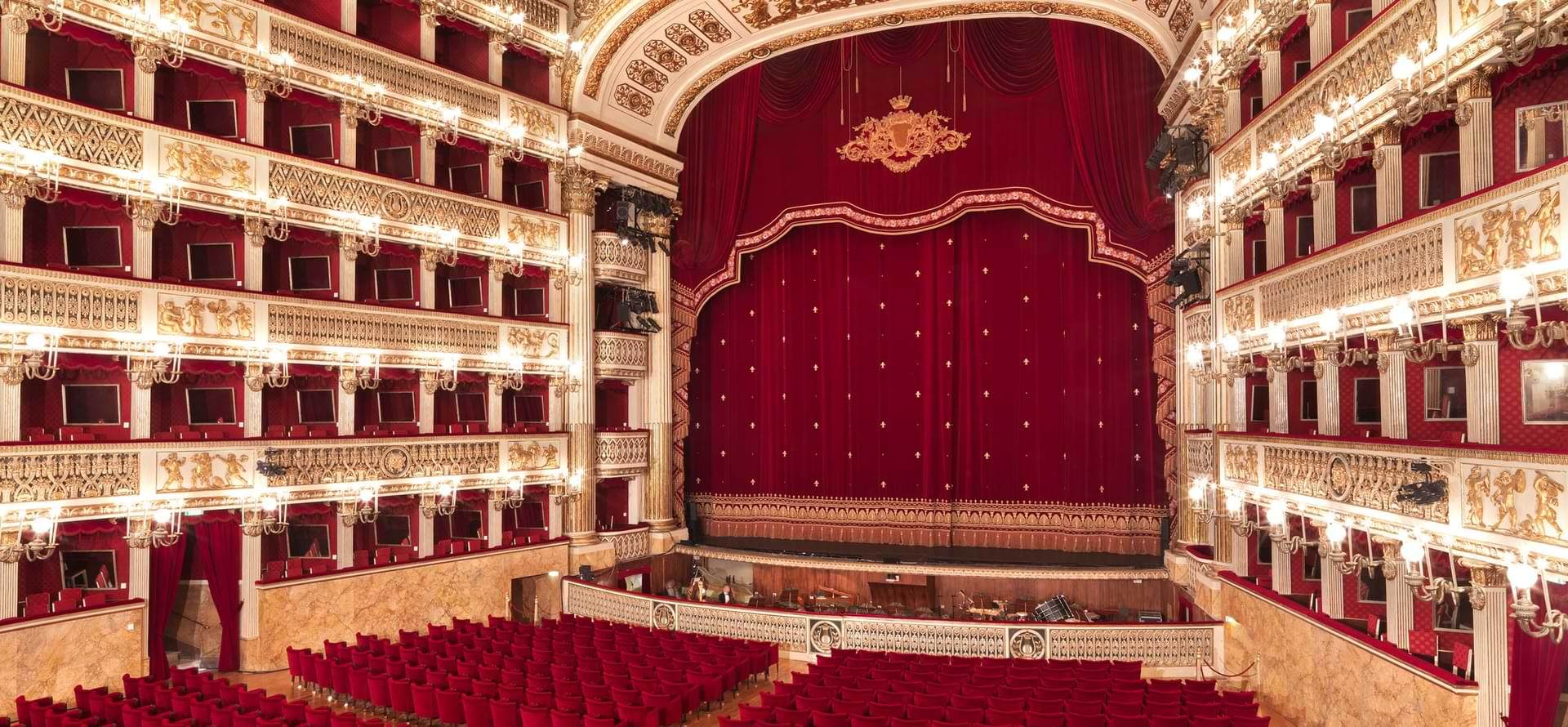La Cenerentola
Mo | Tu | We | Th | Fr | Sa | Su |
Synopsis
In this variation of the traditional Cinderella story, the wicked stepmother is replaced by a wicked stepfather, Don Magnifico. The Fairy Godmother is replaced by Alidoro, a philosopher and the Prince's tutor. Cinderella is identified not by her glass slipper but by her bracelet.
Time: Late 18th century – early 19th century
Place: Italy
Act 1
Angelina ("Cenerentola") is forced to work as the maid in the run-down house of her stepfather Don Magnifico. While his two mean, idle daughters, Clorinda and Tisbe, try on their gowns and jewelry, Cenerentola sings a ballad about a king who found his wife among common folk. A beggar comes calling. Clorinda and Tisbe want to send him away, but Cenerentola offers him bread and coffee. Courtiers arrive to announce that Prince Ramiro is looking for the most beautiful girl in the land to be his bride, and is on his way to pay them a visit. Prince Ramiro arrives, disguised as his own valet in order to observe the women without them knowing. He is immediately struck with admiration for Cenerentola and she for him. Cenerentola has to leave when her stepsisters call her. Don Magnifico enters and Ramiro tells him the Prince will arrive shortly. The "prince" is actually Dandini, Ramiro's valet in disguise. The stepsisters arrive and fawn gleefully over Dandini, who invites them to a ball at the Royal palace. Don Magnifico tells Cenerentola that she cannot accompany them to the ball, despite her pleading. Before leaving, Ramiro notices how badly Cenerentola is treated. His tutor, Alidoro, who had been at the house earlier disguised as the beggar, arrives still wearing his rags and asks for Don Magnifico's third daughter. Magnifico denies she is still alive, but when Alidoro is left alone with Cenerentola, he tells her that she will accompany him to the ball. He throws off his beggar's clothes and identifies himself as a member of Prince Ramiro's court, telling her that heaven will reward her pure heart.
The stepsisters and Don Magnifico arrive at Prince Ramiro's palace, with Dandini still posing as the Prince. Dandini offers Magnifico a tour of the wine cellar, hoping to get him drunk. He then disentangles himself from the family and tells Ramiro how stupid and obnoxious the two sisters are. Ramiro is confused since Alidoro had spoken well of one of Magnifico's daughters. Clorinda and Tisbe enter and impatiently pressure Dandini to declare his "princely" choice. Without committing himself, Dandini ponders the question "Whom will the rejected sister marry?" and suggests Ramiro as a possible husband. Believing him to be a mere valet, the two sisters reject Ramiro as a despicable choice and insult him to his face. Alidoro announces the arrival of an unknown, lavishly dressed yet veiled, lady (Cenerentola). All sense something familiar about her and feel they are in a dream but on the verge of being awakened with a shock.
Act 2
Don Magnifico, Clorinda, and Tisbe are in a room of Ramiro's palace. Magnifico frets over the unknown woman who threatens the chance for one of his daughters to marry Prince Ramiro. The three leave and Ramiro enters, smitten with the unknown woman who resembles the girl he had met that morning. He conceals himself as Dandini arrives with Cenerentola and tries to court her. She turns Dandini down politely, telling him that she is in love with his valet. Ramiro steps forth and declares his love for her. She then leaves giving him one of a pair of matching bracelets and saying that if he really cares for her, he will find her. Encouraged by Alidoro, Ramiro calls his men together to begin searching for her. Meanwhile, Dandini confesses to Don Magnifico that he is really Prince Ramiro's valet. Magnifico becomes highly indignant, and Dandini orders him out of the palace.
At Magnifico's house, Cenerentola, once again dressed in rags, is tending the fire and singing her ballad. Magnifico and his daughters return from the ball in a vile mood, and order Cenerentola to prepare their supper. A thunderstorm rages. Dandini suddenly appears at the door to say that Prince Ramiro's carriage has overturned outside and brings him into the house. Cenerentola fetches a chair for the prince and realizes he is Ramiro. He recognizes her bracelet and the couple are reunited. Don Magnifico, Clorinda and Tisbe are furious. Angered by their cruelty to Cenerentola, Ramiro threatens to punish them, but Cenerentola asks him to be merciful. As Cenerentola leaves with her prince, Alidoro thanks heaven for the happy outcome.
In the throne room of Ramiro's palace, Magnifico tries to curry favour with his stepdaughter, the new princess, but she only wants to be acknowledged as his daughter. Cenerentola asks the prince to forgive Magnifico and the two stepsisters. Her father and stepsisters embrace her as she declares that her days of toiling by the fire are over.
Program and cast
Opera in Italian with surtitles in Italian and English.
Duration: approximately 3 hours, with interval.
Drama giocoso in two acts
Libretto by Jacopo Ferretti
Music by Gioachino Rossini
Director | Speranza Scappucci
; Director | Damiano Michieletto
; Sets | Paolo Fantin
; Costumes | Agostino Cavalca;
Lighting | Alessandro Carletti
Cast:
Angelina (Cinderella) | Aigul Akhmetshina (20, 23, 27) / Aleksandra Meteleva (21, 25)
Don Ramiro | Jack Swanson (20, 23, 27) / Dave Monaco (21, 25)
Dandini | Florian Sempey
Don Magnifico | Giulio Mastrototaro
Clorinda | Laura Ulloa #
Tisbe | Sayumi Kaneko #
Alidoro | Gianluca Margheri
Orchestra and Chorus of the Teatro di San Carlo,
Chorus Master | Fabrizio Cassi
Production Semperoper Dresden and Théâtre des Champs-Élysées
# Former student of the Academy of the San Carlo Theater
Teatro San Carlo Naples Italy
Teatro di San Carlo Napoli; San Carlo Opera House; Real Teatro di San Carlo Naples.
The Real Teatro di San Carlo (Royal Theatre of Saint Charles), its original name under the Bourbon monarchy but known today as simply the Teatro di San Carlo, is anopera house in Naples, Italy. It is located adjacent to the central Piazza del Plebiscito, and connected to the Royal Palace.
It is one of the oldest continuously active venue for public opera in the world, opening in 1737, only five years after the Manoel Theatre in Malta and decades before both the Milan's La Scala and Venice's La Fenice theatres.
The opera season runs from late January to May, with the ballet season taking place from April to early June. The house once had a seating capacity of 3,285.but nowadays has been reduced to 1414 seats.[3] Given its size, structure and antiquity was the model for the following theatres in Europe.
History of the opera house
Commissioned by the Bourbon King Charles VII of Naples (Carlo VII in Italian), Charles wanted to endow Naples with a new and larger theatre to replace the old, dilapidated, and too-small Teatro San Bartolomeo of 1621, which had served the city well, especially after Scarlatti had moved there in 1682 and had begun to create an important opera centre which existed well into the 1700s.
Thus, the San Carlo was inaugurated on 4 November 1737, the king's name day, with the performance of the opera Domenico Sarro's Achille in Sciro, which was based on the 1736 libretto by Metastasio which had been set to music that year by Antonio Caldara. As was customary, the role of Achilles was played by a woman, Vittoria Tesi, called "Moretta"; the opera also featured soprano Anna Peruzzi, called "the Parrucchierina" and tenor Angelo Amorevoli. Sarro also conducted the orchestra in two ballets as intermezzi, created by Gaetano Grossatesta, with scenes designed by Pietro Righini. The first seasons highlighted the royal preference for dance numbers, and featured among the performers famous castrati.
In the late 18th century, Christoph Willibald Gluck was called to Naples by the impresario Tufarelli to direct his 1852 Clemenza di Tito at the theatre, and Johann Christian Bach in 1761-62 brought two operas, Catone in Utica and Alessandro nell'Indie.
1737: Construction of the Teatro di San Carlo
The new opera house was designed by Giovanni Antonio Medrano, a military architect, and Angelo Carasale, the former director of the San Bartolomeo. The horseshoe-shaped auditorium is the oldest in the world. It was built at a cost of 75,000 ducats. The hall was 28.6 meters long and 22.5 meters wide, with 184 boxes, including those of proscenium, arranged in six orders, plus a royal box capable of accommodating ten people, for a total of 1,379 seats. Including standing room, the theatre could hold over 3,000 people. The fastidious composer and violinist Louis Spohr reviewed the size and acoustic properties of this opera house very thoroughly on 15 February 1817 and concluded that:
there is no better place for ballet and pantomime. Military movements of infantry and cavalry, battles, and storms at sea can be represented here without falling into the ludicrous. But for opera, itself, the house is too large. Although the singers, Signora Isabella Colbran, [Prima Donna of the Teatro San Carlo opera company and Rossini's future wife], and the Signori Nozzari, Benedetti, etc., have very strong voices, only their highest and most stentorian tones could be heard. Any kind of tender utterance was lost.
Much admired for its architecture, its gold decorations, and the sumptuous blue upholstery (blue and gold being the official colours of the Bourbons), the San Carlo was now the biggest opera house in the world.[6] In relation to the power of the existing Bourbon Kingdom of the Two Sicilies, Beauvert notes that the design of the house, with its 184 boxes lacking any curtains was so that "no one could avoid the scrutiny by the sovereign" who had his private access from the Royal Palace.
In 1809 Domenico Barbaia was appointed manager of the royal opera houses in Naples and remained in charge until 1841. He soon established a reputation for innovative and dazzling productions, which attracted both the public and leading singers to the opera house.

 EN
EN DE
DE IT
IT FR
FR ES
ES RU
RU JP
JP RO
RO
 Seating plan
Seating plan